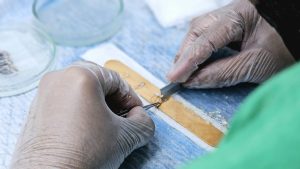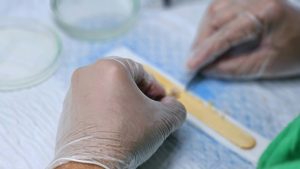Hair transplant
A hair transplant is a surgical method of hair follicles. The method is mostly applied to cure male pattern baldness. In this minimally invasive surgery grafts with hair follicles that are resistant to balding genetically such as the back of the head are moved to the balding scalp.
They can also be utilized to rebuild eyelashes eyebrows beard hair chest hair pubic hair and to close scars resulting from accidents or surgery like facelifts and prior hair transplants. It is distinct from skin grafting because grafts include nearly all of the epidermis and dermis around the hair follicle and numerous small grafts are implanted instead of a single piece of skin.
As hair grows naturally in clusters of 1 to 4 hairs current methods harvest and transplant hair follicular units in their natural clusters. Therefore, modern hair transplantation can provide a natural look by replicating natural hair direction. This hair transplantation method is known as follicular unit transplantation. Donor hair may be taken in two different methods strip harvesting and follicular unit extraction.
Contemporary hair restoration surgery relies on a method called follicular unit transplantation, wherein follicular units are the only structures utilized as hair grafts. we outline how the methods used in hair transplantation have developed into their current configurations. Anatomic principles of particular interest to dermatologists are presented, such as the distribution and ex vivo morphology of scalp follicular units. Male androgenetic alopecia and female pattern hair loss are the most frequent indications for hair loss referrals to dermatologists and will be the main concern of this review.

But since not all scalp disorders are transplantable this review will also outline which scalp disorders are amenable to surgery and which are not. Guidelines are offered to assist dermatologists in further delineating good and bad candidates for hair transplantation. Other indications for which hair transplantation surgery is performed are discussed. Hair transplantation is a surgical procedure of hair restoration.
Physician qualification
The doctor who does hair transplantation should have undergone post-graduation training in dermatology he should be well-trained in dermato surgery at a centre that offers education training in cutaneous surgery. Furthermore, he should receive specific hair transplantation training or experience at the surgical table hands on under the supervision of an appropriately trained and experienced hair transplant surgeon. Along with the surgical technique training should be instruction in local anesthesia and emergency resuscitation and care.
Facility
Hair transplantation can be safely performed in an outpatient day case dermatosurgical facility.
The day case theatre must be provided with equipment for monitoring and dealing with emergencies. There should be an emergency plan in place and all nurses should be familiar with the emergency plan. A stand by anesthetist would be preferable, but not necessary. Indication for hair transplant is pattern loss in males and also in females. Female pattern hair loss studies to eliminate any hidden cause of hair loss like anemia and thyroid deficiency should be conducted. Hair transplantation can also be done in selected cases of scarring alopecia, eyebrows and eye lashes, by skilled surgeons.
Preoperative counseling and informed consent Detailed consent form listing details about the procedure and possible complications should must be signed by the patient. Consent form must particularly mention the limits of the procedure and if further procedures are to be undertaken for optimal results, it must clearly be mentioned. Patient must be given sufficient opportunity to gather information through brochures, computer presentations, and personal counseling. Importance of concomitant medical therapy must be highlighted. Proper hair growth is to be expected after approximately 9 months.
following transplantation.
Laboratory tests prior to surgery that are to be carried out are Hb%, counts of blood including platelet, bleeding time or prothrombin time and activated partial thromboplastin time blood chemistry profile with sugar.
Follicular unit hair transplant is the golden standard technique of hair transplant it maintains the normal structure of hair units and provides natural results.
Mini-micro-grafting is a technique hair transplant using randomly selected groups of hairs, without regard to their natural arrangement of follicular units on examination under loupe or naked eye.
Mini-grafts are made up of 4-5-6 hairs and micro grafts are made up of 1-3 hairs. Punch produces unsightly cosmetically unacceptable results and need not be used anymore.
Patient Selection
Hair transplantation may be done in any individual with pattern hair loss with good donor area, in good overall health and reasonable expectations. Care should be taken in, very young patients whose initial alopecia is still in the developmental stage, Norwood grade VI or VII patients with poor density patients with unrealistic expectations and patients with severe systemic health issues.
Medical therapy
The majority of patients will require simultaneous medical therapy as the mechanism of pattern alopecia is ongoing and can damage the remaining hairs.

Manpower
Hair transplanting is a team activity. Especially, undertaking large sessions, requires an expert team of experienced assistants. Anesthesia 2% lignocaine with adrenaline is used in most cases tumescent technique is to be employed. Bupivacaine has
has been employed by some writers in consideration of its long action duration. Donor dissection Strip dissection by single blade is ideal for donor area. Steromicroscopic dissection is ideal for hair unit dissection in follicular unit transplantation mini-micro-grafting does not require microscopic dissection.
Recipient insertion Different
techniques and various instruments have been employed for recipient site formation; these are based on the preference of the operating surgeon and have been mentioned in the guidelines. Preservation of the graft is necessary for survival. Density Minimum density of 35-45 units per sq cm is advocated. Result is donor-dependent, technique employed and personal ability of the surgeon.
Hair loss treatment
Hair loss is a universal problem seen in both men and women. The most common cause is androgenetic alopecia, but the loss of hair due to other causes of alopecia including trauma dermatoses and systemic illnesses may be seen. Alopecia may produce significant impact on ones sense of self worth and overall emotional well being since a persons image contributes to function in the workplace and interpersonal dynamics. It’s no wonder, then, that methods to treat hair loss are commonly pursued. Hair transplant surgery is now very common, and the outcome that we can achieve today is very good offering a natural look when done properly.
Despite this, hair transplant surgery is not flawless. It is not flawless because the hair transplant surgeon still has to contend with limitations that bar the attainment of maximum results. Some of these include a restriction to donor hair availability, survival of the hair, and how to cover up evidence that a surgery has been conducted. This article discusses some of the most critical challenges in hair restoration surgery currently and potential solutions to these issues. Two of such methods demonstrate these factors Follicular unit extraction and Body hair transplantation.
In spite of the recent developments, like trichophytic closure, not all receive a pencil line scar following strip method, which would be apparent if hairs are maintained short. FUE talked about in this edition by Dua A and Dua K, was a consequence of such a trend to maintain hairs short and the discontent with linear scar of strip method. The basis of the technique was originally outlined by Rassman in their interesting article. Originally scoffed at as a reinvention of the scandalous punch, it has now become an accepted technique in hair transplantation, with close to 10% of all transplants being performed using this technique.
There has been an Internet explosion of sites eulogizing and even overstating the benefits of this technique and denigrating the strip. Nonetheless, while it is an intriguing development, it is less ideal than FUT. It takes longer, has more transection of the follicles, is more costly and thus currently best for small sites. Nevertheless, developments have been ongoing, with newer techniques of automation emerging, which ought to lead to quicker and more precise extraction and perhaps reduction of cost.
Surgeons are now doing megasessions of 2000 grafts a day. Definitely, FUE heals faster and provides liberty to the patient to have short hairs. Above all, it can be used in association with FUT to provide more grafts to a patient, without harvesting broader strips. Body hair, first described by Woods R has provided additional source of grafts.
The work by Hwang S for which he was awarded with the platinum follicle award by the International society for hair restoration surgery laid the foundation for recipient influence and proved that body hairs are capable of growing longer if transplanted to scalp. The FUE technique is ideally placed to harvest body hair and has made it possible for us to provide an ever increasing number of grafts to a patient within 2 3 days.
Yet, similar to FUE, it is time-consuming, costly and waits for methods to be developed to raise the speed and accuracy of extraction. Yet, as in the case of FUE, over-hyping of the method on Internet websites have caused numerous patients to undergo the procedure without being aware of the downsides.
